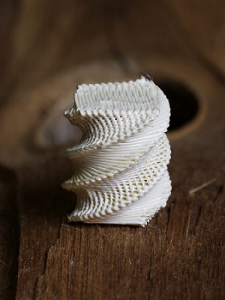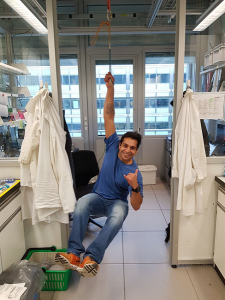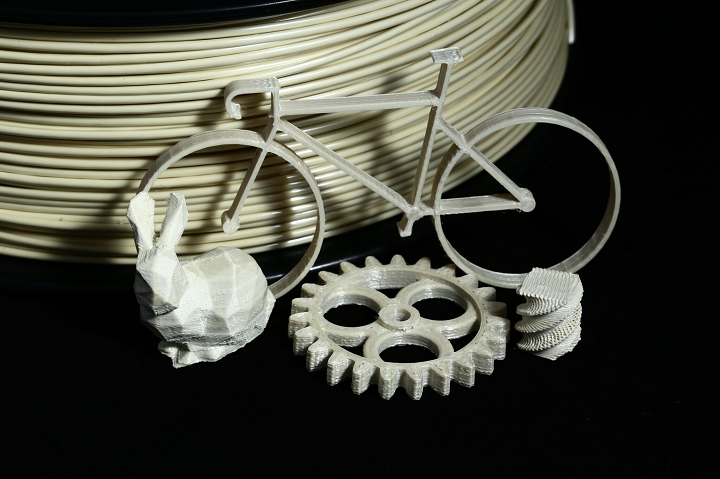While it’s possibly to quickly manufacture complex parts at a low cost using fused deposition modeling (FDM) 3D printing, the readily available polymers are fairly weak, and the completed 3D prints have poor adhesion. According to an ETH Zürich research group that specializes in 3D printing complex materials, this one of the reasons why FDM is not used successfully to fabricate commercial products.
 Polymer performance has been traditionally increased by adding strong, stiff, continuous fibers into the material, like glass or carbon, but it takes a lot of time, effort, and expensive equipment to develop these composite materials, which are also difficult to recycle. But the researchers have developed a bio-inspired approach to 3D print recyclable liquid crystal polymer (LCP) materials using desktop FDM systems.
Polymer performance has been traditionally increased by adding strong, stiff, continuous fibers into the material, like glass or carbon, but it takes a lot of time, effort, and expensive equipment to develop these composite materials, which are also difficult to recycle. But the researchers have developed a bio-inspired approach to 3D print recyclable liquid crystal polymer (LCP) materials using desktop FDM systems.
According to a press release, “For the first time, researchers from the Complex Materials group and the Soft Materials group at ETH Zürich, were able to print objects from a single recyclable material with mechanical properties that surpass all other available printable polymers and can compete even with fibre-reinforced composites.”
During development, the team was inspired by two materials found in nature: wood and spider silk, the latter of which has inspired other 3D printing innovations in the past. The material’s silk proteins have a high degree of molecular alignment along the fiber directions, which gives spider silk its “unrivalled mechanical properties.”

3D printed samples of specimens with print lines following the stress lines and the biological inspiration represented by a wood knot.
The researchers were able to duplicate this high alignment during extrusion by using an LCP as FDM feedstock material. This gave the material excellent mechanical properties in the deposition direction. In addition, its anisotropic fiber properties were put to good use by “tailoring the local orientation of the print path according to the specific loading conditions imposed by the environment,” which was inspired by how living tissue, like wood, can arrange fibers along its stress lines while it grows and adapts to its surrounding environment.
The team published a paper on their work with 3D printing strong LCPs, titled “Three-dimensional printing of hierarchical liquid-crystal-polymer structures,” in the Nature journal.
The abstract reads, “Fibre-reinforced polymer structures are often used when stiff lightweight materials are required, such as in aircraft, vehicles and biomedical implants. Despite their very high stiffness and strength, such lightweight materials require energy- and labour-intensive fabrication processes, exhibit typically brittle fracture and are difficult to shape and recycle. This is in stark contrast to lightweight biological materials such as bone, silk and wood, which form by directed self-assembly into complex, hierarchically structured shapes with outstanding mechanical properties, and are circularly integrated into the environment. Here we demonstrate a three-dimensional (3D) printing approach to generate recyclable lightweight structures with hierarchical architectures, complex geometries and unprecedented stiffness and toughness. Their features arise from the self-assembly of liquid-crystal polymer molecules into highly oriented domains during extrusion of the molten feedstock material. By orienting the molecular domains with the print path, we are able to reinforce the polymer structure according to the expected mechanical stresses, leading to stiffness, strength and toughness that outperform state-of-the-art 3D-printed polymers by an order of magnitude and are comparable with the highest-performance lightweight composites. The ability to combine the top-down shaping freedom of 3D printing with bottom-up molecular control over polymer orientation opens up the possibility to freely design and realize structures without the typical restrictions of current manufacturing processes.”
The team’s materials, in addition to being more easily recyclable, are far stronger than typical 3D printed composite polymers, and are not nearly as difficult to fabricate. This means that it should now be possible to 3D print FDM structures for industry use as lightweight, structural parts.
“Because the research has been conducted using a readily available polymer and a commercial desktop printer, it should be easy for the broader additive manufacturing and open source communities to adopt this new material and digitally design and fabricate strong and complex lightweight objects from LCPs,” the ETH Zürich press release states. “Thus, the technology is expected to be a game-changer in several structural, biomedical and energy-harvesting applications and finally enable complex FDM printed parts that mimic natural structural designs to be manufactured for the mass market.”
Co-authors of the paper are Silvan Gantenbein, Kunal Masania, Wilhelm Woigk, Jens P. W. Sesseg, Theo A. Tervoort, and André R. Studart.
Discuss this research and other 3D printing topics at 3DPrintBoard.com or share your thoughts below.
Subscribe to Our Email Newsletter
Stay up-to-date on all the latest news from the 3D printing industry and receive information and offers from third party vendors.
Print Services
Upload your 3D Models and get them printed quickly and efficiently.
You May Also Like
Consolidation in AM: How 2025 Is Shaping the Industry’s New Normal
The first half of 2025 has been marked by a clear shift in the additive manufacturing (AM) industry. Companies are no longer just focused on developing new tech by themselves....
Etsy Design Rule Change Reduces Selection of 3D Printed Goods
Online marketplace Etsy has implemented a rule change requiring all 3D printed goods on the site to be original designs. The update to the site’s Creativity Standards states, ¨Items produced using...
U.S. Congress Calls Out 3D Printing in Proposal for Commercial Reserve Manufacturing Network
Last week, the U.S. House of Representatives’ Appropriations Committee moved the FY 2026 defense bill forward to the House floor. Included in the legislation is a $131 million proposal for...
Transforming From Tourist to Native: Duro CEO Michael Corr Explains Why the Company Rebuilt its PLM Software on AI
In these early innings of the AI boom, many market analysts have expressed concern that AI spend has gotten too far ahead of the technology’s proven ability to deliver significant...



































